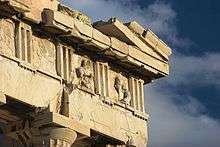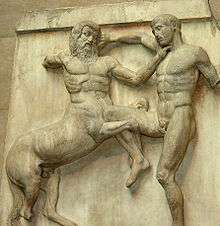Metopes of the Parthenon

The Metopes of the Parthenon are a series of marble panels, originally 92 in number, on the outside walls of the Parthenon in Athens, Greece, forming part of the Doric frieze. The metopes of each side of the building (14 each on the eastern and western walls, 32 each on the northern and southern walls) had a different subject, and together with the pediments, Ionic frieze, and the statue of Athena Parthenos contained within the Parthenon, formed an elaborate program of sculptural decoration. Fifteen of the metopes from the south wall were removed and are now part of the Parthenon Marbles in the British Museum, and others have been destroyed. They are famous examples of the Classical Greek high-relief.
The East Metopes
The fourteen East metopes were situated above the main entrance. They depict the final stages of the cosmogonic battle between the Olympian gods and the Giants (Gigantomachy). The fight develops around the central figure of Zeus (Plaque No. 8) followed by his chariot ridden by Hera (Plaque No. 7). His brother Poseidon with his chariot is shown close by (Plaque No. 6) throwing the island of Nisyros over the defeated Giant Polybotes. Although the figure of Heracles has not yet been identified from the remaining fragments, it is almost certain that the hero, whose contribution to the victory of the Olympian gods was significant, was present. The felicitous outcome of the battle is implied with the scene of Helios (sun-god) and his chariot rising from the night (Plaque No. 14), a new era was about to commence. The East metopes are in extremely poor condition, and the identification of most of the figures is tentative at best.[1]
The South Metopes
The metopes of the southern wall (Plaques No. 1–12 and 21–32) present the Battle of the Lapiths and Centaurs, also known as the Centauromachy, in which the mythological Athenian king Theseus took part. The battle between the Centaurs and the Lapiths broke out during the wedding feast of the king of the Lapiths and personal friend of Theseus, Pirithous. According to one version of the myth, the Centaurs, insulted from being excluded from the celebrations, attacked the Lapiths while according to another, during the feast drunken Centaurs reacted violently under the influence of wine. The result was a fight between the Centaurs and the Lapiths and an attempt of the former to abduct the Lapith women.
The Centaurs have faces with animal features whose linear drawings strongly recall theatrical masks. They are shown wearing animal skins and they are armed with tree-branches. On the other hand, the Lapiths fight nude or wearing a chlamys, several of them hold a sword or a spear which, as they were formerly metallic attachments, are now lost, while in some cases, the Lapiths use shields to protect themselves.
There is a tendency to recognize the bridegroom Pirithous on metope 11 and the bride Deidamia on metope 25 but there is no conclusive evidence for these identifications. On metope 29, features of the mature Classical style can be traced on the face and the dress of the Lapith woman.
The presence of household utensils such as hydrias (ceramic pots with three handles used for mainly for storing water), which are also used as provisional weapons by the combatants, indicates a battle fought indoors. Certain compositions are repeated whereas the overall execution of the scenes is less ambitious than the initial plans. Contrary to the eventual outcome of the battle and to the moral of the myth which emphasizes on the superiority of the civilized world over the primeval disorder, the winning party in this fearless fight are the Centaurs and not the Lapiths. However, it is possible that the battle is still in its initial stages.
In 1687, a cannonball struck the Parthenon during an attack on Athens by the Venetians. This event destroyed many metopes on the south wall, especially the central ones. The existence of these metopes is now known only from Carrey's drawings executed in 1674 and from their remaining fragments. Their subject matter is not altogether clear as the metopes present uncommon iconographical details. Some experts recognize on them the representation of Attic dynastic myths (the stories of the royal families of Cecrops and Erechtheus) while others, attempting to unify mythologically the afore-mentioned scenes with the ones of the Centauromachy, propose a subject related to the myths of the Centauromachy heroes.
The West Metopes
The subject of the west metopes is the legendary invasion of Athens by the Amazons (Amazonomachy). Scholars consider these metopes, which show the Amazons in eastern dress, to be a reference to the Persian Wars.
The North Metopes
The north metopes show scenes of the Greeks warring with the Trojans (Iliupersis).[2] These metopes are often referred to as the Sack of Troy, and depict the Trojan War. Only 14 of the original 32 north panels have survived to modern times and are displayed in the Acropolis Museum in Athens.
Symbolism of the Metopes
The northern, eastern, southern, and western metopes served a dual function on the Parthenon. On one hand, they represented scenes from well-known mythology and history; however, more generally, they are also thought to have represented the triumph of reason and order, generally in the form of the Greeks/Athenians or their gods, over animal passion and chaos.[3]
References
- ↑ Tiverios, M. A. (1 January 1982). "Observations on the East Metopes of the Parthenon". American Journal of Archaeology. 86 (2): 227–229. doi:10.2307/504834. JSTOR 504834.
- ↑ Kousser, Rachel (2009). "Destruction and Memory on the Athenian Acropolis". The Art Bulletin. 91 (3): 263. doi:10.1080/00043079.2009.10786154. JSTOR 40645507.
- ↑ Stokstad, Marilyn; Cothren, Michael W. (2011), Art History, Prentice Hall, p. 133, ISBN 0-205-74422-2

